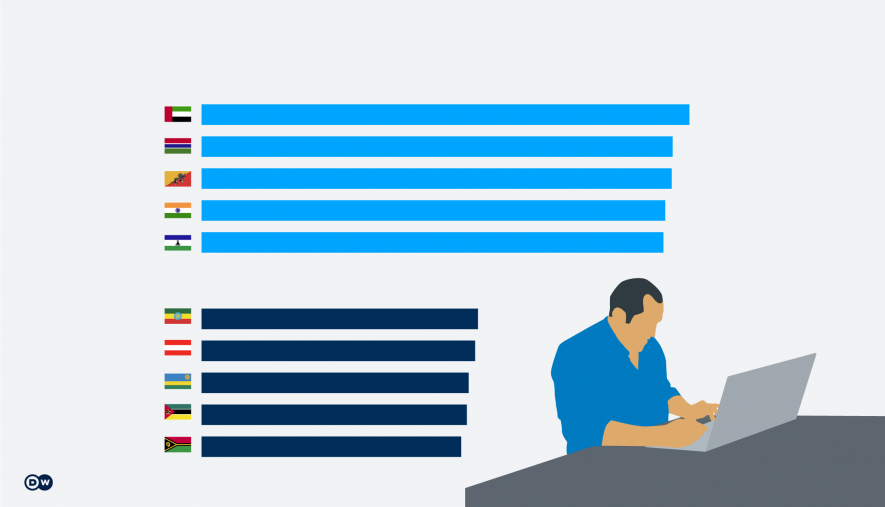How the World of Work is Changing

Chile recently announced plans to bring down the number of working hours. Staggered over five years, Chileans will eventually work just 40 hours a week instead of the current 45.
Along with Ecuador, Chile will have the shortest work week in Latin America — a region that has the world's longest official work hours. By comparison, Argentina, Mexico, Peru and Panama have 48-hour work weeks, while in Brazil it's 44.
The law vs. reality
Most countries have statutory working hours that protect workers from being forced to put in too much overtime. But in reality, they are often pressured to put in many more hours than the law requires.
Japan, for example, has a term for workaholic employees — Karoshi — or literally death by overwork. The country does have a 40-hour work week. But abuse is so high, the government had to pass another law in 2018 that specifically limits overtime to around 30 hours per month.
Despite this, a survey last year found that 37% of 18,000 firms still required their workers to do a lot of overtime — an average of 80 unpaid hours per month.
The United States is also famous for its hustle culture, where workers are expected to put in several hours of overtime a week. Certain sectors of the economy like law, finance and technology are notorious for piling work on their staff.
Reports of tech workers sleeping under their desks are commonplace, while surveys show many lawyers work up to 60 hours a week to meet their firms' billable hours targets.
US workers put in an average of 1,791 hours per year, 442 more than German workers and 301 more than French workers, according to stats from the Organisation for Economic Co-operation and Development (OECD).
Not all countries are following Chile's example to cut working hours. South Korea had planned this year to raise the maximum working time to 69 hours as companies complained that the current 52 hours wasn't enough to help them meet deadlines. But younger workers staged mass protests against the plan, forcing the government to reconsider. In 2021, South Koreans officially worked 1,915 hours.
France, of course, became famous for introducing a 35-hour week in 2000. Although it was widely interpreted as improving work-life balance, the measure was an attempt to cut unemployment, which had reached a record high of 12.5%. The 35-hour week was also meant to be the point where paid overtime should kick in.

Political systems, working hours and quality of work
Higher quality of working environment — hours worked, benefits, paid holidays, pension and health systems — often correlates with more advanced democracies, where companies, trade unions and the state have developed a system of collective bargaining. However, that doesn't show up in the latest ILO data (above) where mostly non-European nations work the least hours in a week.
Overall, developed countries generally have shorter official workweeks and more vacation days, due to cultural demands for adequate leisure time. They also trend toward more generous overtime compensation and more favorable parental leave laws.
Improved working practices began in the 19th century and expanded massively after World War II. Today, in comparison, only 15% of workers in EU countries officially work more than 48 hours per week, while in China and South Korea, over 40% of workers do so and in Chile it is over 50%.
Chile's military dictatorship under General Augusto Pinochet from 1970 to 1990 severely curtailed trade union bargaining for higher wages and a welfare safety net under an experiment with Monetarism (using the supply of money to stabilize the economy).
Other countries in Latin America followed suit together with the UK under Margaret Thatcher and the US under Ronald Reagan in the 1980s. The concept of increasing productivity and a welfare state system was deemed largely incompatible.
Working hours tied to contentment
One OECD country among those with the shortest workweeks is Denmark, which ranks as one of the happiest countries in the world. Denmark is known for the concept of "hygge," which is described as "creating a warm atmosphere and enjoying the good things in life with good people."
In France and Germany, too, a large state combines to produce a work-life balance. People in Italy still in fact enjoy the best work-life balance, according to the OECD. Employed Italians have the most time for leisure and personal activities, while only 3% of employees in the country work very long hours (50 or more hours a week).
Another major factor leading to contented workers is their incomes. The middle and working classes of the US and UK have seen stagnant or declining real wages since around 1980 when Monetarist — or so-called neo-liberal — policies first took hold in the Anglo-Saxon economies.
Today, faced with a political backlash from those largely excluded from reaping the benefits of rising growth, many free-market conservatives argue that a smaller state and low-taxed businesses will help grow wages. The bigger the pie, the more to go around, no matter the relative sizes of the slices.
But with artificial intelligence (AI) arriving, an aging population and the world’s productive base and power shifting to Asia, the question of quality of work is again on the political table. France under President Emmanuel Macron is a key test case. Why, many French people ask, should they pay for lower growth and productivity with shorter retirement? Who is right is a political choice.
Worklife in a post-pandemic world
COVID allowed tens of millions of office-based staff to work from home, spurring calls, as economies recovered, to retain a better work-life balance by avoiding long commutes and child care costs. Many companies still allow staff to work entirely remotely or through a hybrid system of office and home.
Consultancy McKinsey calculated that about 20% of workforces in advanced economies could continue to work from home between three and five days a week long-term without impacting productivity.
The introduction of nomad worker visas in many countries was spurred by employees' demands to work from anywhere in the world, including Thailand, Spain, and Croatia.
Other countries are experimenting with four-day work weeks, including Belgium, which now allows employees to choose whether to do the same number of hours over a four- or five-day week.
In the UK, dozens of companies signed up for a trial by Cambridge and Oxford University along with Boston College, to test the impact on productivity from a 4-day week. Almost all of the firms subsequently continued with the new arrangement. Sweden and Iceland have conducted similar trials, while Spain is also offering to subsidize the wages of companies that take part in its upcoming experiment.
Despite scary headlines that hundreds of millions of jobs will be replaced by AI in the near future, many proponents of the technology see generative AI platforms like ChatGPT as primarily human aids, although the platforms are improving by the day. Many argue that it will take decades to replace humans entirely and until then, AI can free up the many who complain of overwork to concentrate on other productive tasks.
Edited by: Uwe Hessler
Get the latest reports & analysis with people's perspective on Protests, movements & deep analytical videos, discussions of the current affairs in your Telegram app. Subscribe to NewsClick's Telegram channel & get Real-Time updates on stories, as they get published on our website.
























